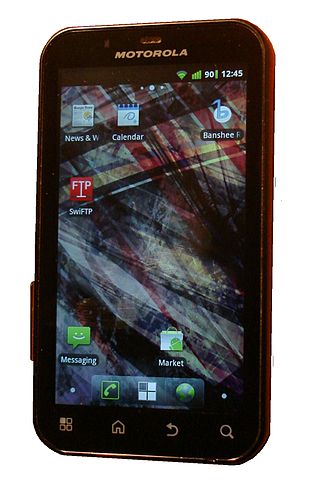
A smartphone is a mobile device that combines the functionality of a traditional mobile phone with advanced computing capabilities. It typically has a touchscreen interface, allowing users to access a wide range of applications and services, such as web browsing, email, social media, and multimedia playback. Smartphones also have built-in cameras, GPS navigation, and support for various communication methods, including voice calls, text messaging, and internet-based messaging apps.

An input method is an operating system component or program that enables users to generate characters not natively available on their input devices by using sequences of characters that are available to them. Using an input method is usually necessary for languages that have more graphemes than there are keys on the keyboard.

Japanese input methods are used to input Japanese characters on a computer.

A virtual keyboard is a software component that allows the input of characters without the need for physical keys. The interaction with the virtual keyboard happens mostly via a touchscreen interface, but can also take place in a different form in virtual or augmented reality.
TouchPal is an alternative input method for mobile devices, designed and developed by Shanghai-based CooTek. It is a software application running on multiple platforms, including Android, iOS, Windows Mobile, and Windows 8. It simulates a keyboard on the screen of the device, which is used to enter text by tapping on the screen or sliding a finger between letters constructing the word. It is an optional text input method to the traditional physical keyboards and default keyboards provided by the device manufacturer.

The HTC Dream is a smartphone developed by HTC. First released in September 2008, the Dream was the first commercially released device to use the Linux-based Android operating system, which was purchased and further developed by Google and the Open Handset Alliance to create an open competitor to other major smartphone platforms of the time, such as Symbian, BlackBerry OS, and iPhone OS. The operating system offers a customizable graphical user interface, integration with Google services such as Gmail, a notification system that shows a list of recent messages pushed from apps, and Android Market for downloading additional apps.
Bengali input methods refer to different systems developed to type the characters of the Bengali script for Bengali language and others, using a typewriter or a computer keyboard.

The HTC Desire Z is a slider-style smartphone developed by HTC Corporation and announced on 15 September 2010; it was released in Europe and Canada in November 2010, following a number of delays related to Google's quality assurance tests. Other than its slider configuration, the Desire Z features specifications similar to the HTC Desire and the HTC Desire HD. The design of the HTC Desire Z has capacitive face buttons rather than the mechanical ones the HTC Desire features.

The Motorola Defy (A8210/MB525) is an Android-based smartphone from Motorola. It filled a niche market segment, by being one of the few small, IP67 rated smartphones available at the time of its late 2010 release; it is water resistant, dust resistant, and has an impact-resistant screen. An updated version of the original model, Defy+ (MB526) was released in 2011. Other variants were also released before a revival of the Defy name in 2021.

In a speed typing contest contestants compete to attain the highest accurate typing speeds. These contests have been common in North America since the 1930s and were used to test the relative efficiency of typing with the Dvorak and QWERTY keyboard layouts.

Ginger Software is an American and Israeli start-up specialized in Natural Language Processing and AI. The main products are tools aiming to improve written communications, develop English speaking skills and boost productivity. The company was founded in 2008 by Yael Karov and Avner Zangvil. Ginger Software uses the context of complete sentences to suggest corrections. In December 2011, Ginger Software was one of nine projects approved by the Board of Governors of the Israel-U.S. Binational Industrial Research and Development Foundation for a funding of $8.1 million. The company also raised $3 million from private Israeli and US investors in 2009.
ETAOI keyboard is a text input software for touch screen-reliant devices. It is based on ETAOI method for coding.

Microsoft SwiftKey is a virtual keyboard app originally developed by TouchType for Android and iOS devices. It was first released for Android in July 2010, followed by an iOS release in September 2014 following Apple's implementation of third-party keyboard support.

Android Jelly Bean is the codename given to the tenth version of the Android mobile operating system developed by Google, spanning three major point releases. Among the devices that run Android 4.1 to 4.3 are the Nexus 7 (2012), Nexus 4, Nexus 10, Nexus 7 (2013), and Hyundai Play X.

Fleksy is a third-party, proprietary virtual keyboard app for Android and iOS devices. It attempts to improve traditional typing speed and accuracy through enhanced auto-correction and gesture controls. Fleksy uses error-correcting algorithms that analyze the region where the user touches the keyboard and feeds this through a language model, which calculates and identifies the intended word. Swiping gestures are used to control common functions, such as space, delete, and word correction.
The KALQ keyboard is a keyboard layout that has been developed by researchers at the Montana Tech, University of St Andrews and the Max Planck Institute for Informatics as a split-screen keyboard for thumb-typing, which is claimed to allow a 34% increase in speed of typing for the people who use touchscreen. KALQ was released as a free app, albeit a beta, for Android-based smartphones. Although the KALQ project received some buzz in tech media, as of early 2017, the latest public version is dated October 2013, and still labelled a beta.

Swarachakra is a free text input application developed by the IDIN group at Industrial Design Center (IDC), Indian Institute of Technology Bombay for Indic scripts. Swarachakra's alphabetical keyboard layout performed better than the Inscript layout. Currently, it is available for Android devices in twelve languages.

MessagEase is an input method and virtual keyboard for touchscreen devices. It relies on a new entry system designed by Saied B. Nesbat, formatted as a 3x3 matrix keypad where users may press or swipe up, down, left, right, or diagonally to access all keys and symbols. It is a keyboard that was designed for devices like cell phones, mimicking the early cell phones' limited number of 12 keys.

Android Pie, also known as Android 9 is the ninth major release and the 16th version of the Android mobile operating system. It was first released as a developer preview on March 7, 2018, and was released publicly on August 6, 2018.
The version history of the HarmonyOS distributed operating system began with the public release of the HarmonyOS 1.0 for Honor Vision smart TVs on August 9, 2019. The first commercial version of the IoT based operating system, HarmonyOS 2.0, was released on June 2, 2021 for phones, tablets, smartwatches, smart speakers, routers, and internet of things. Beforehand, DevEco Studio, the HarmonyOS app development IDE, hat been released in September 2020 together with the HarmonyOS 2.0 Beta. HarmonyOS is developed by Huawei. New major releases are announced at the Huawei Developers Conference (HDC) in the fourth quarter of each year together with the first public beta version of the operating system's next major version. The next major stable version is then released in the third quarter of the following year.
















